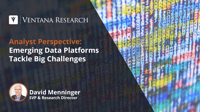If I had a magic wand, I would want to add scenario evaluation to all business intelligence tools on the market. I have previously written about the need to make intelligent decisions with decision intelligence. The data and analytics markets have evolved so that organizations have far greater capabilities to utilize data in decision-making processes. While there is some convergence around the concept of decision intelligence, there are still several “islands” of decision-making. Analyzing...
Read More
Topics:
business intelligence,
Analytics,
Business Planning,
Digital Technology,
Analytics & Data
Organizations are becoming increasingly aware of the potential value that can be gained by processing big data. As data sources grow, it becomes important to have tools and methods to effectively process, analyze and visualize this information from disparate systems and warehouses.
Read More
Topics:
business intelligence,
embedded analytics,
Analytics,
Streaming Analytics
For far too long, business intelligence technologies have left the rest of the exercise to the reader. Many of these tools do an excellent job providing information in an interactive way that lets organizations dive into the data and learn a lot about what has happened across all aspects of the business. More recently, many of these tools have added augmented intelligence capabilities that help explain why things happened. But rarely did any of these tools provide information about what to do...
Read More
Topics:
business intelligence,
Analytics,
Digital Technology,
AI & Machine Learning,
Analytics & Data
How does your organization define and display its metrics? I believe many organizations are not defining and displaying metrics in a way that benefits them most. If an organization goes through the trouble of measuring and reporting on a metric, the analysis ought to include all the information needed to evaluate that metric effectively. A number, by itself, does not provide any indication of whether the result is good or bad. Too often, the reader is expected to understand the difference, but...
Read More
Topics:
business intelligence,
Analytics,
Internet of Things,
Data,
Digital Technology,
Streaming Analytics,
AI & Machine Learning
Organizations are dealing with exponentially increasing data that ranges broadly from customer-generated information, financial transactions, edge-generated data and even operational IT server logs. A combination of complex data lake and data warehouse capabilities are required to leverage this data. Our research shows that nearly three-quarters of organizations deploy both data lakes and data warehouses but are using a variety of approaches which can be cumbersome. A single platform that can...
Read More
Topics:
business intelligence,
embedded analytics,
Analytics,
Collaboration,
Data Governance,
Data Preparation,
Information Management,
Data,
data lakes,
AI & Machine Learning
Organizations are always looking to improve their ability to use data and AI to gain meaningful and actionable insights into their operations, services and customer needs. But unlocking value from data requires multiple analytics workloads, data science tools and machine learning algorithms to run against the same diverse data sets. Organizations still struggle with limited data visibility and insufficient insights, which are often caused by a multitude of reasons such as analytic workloads...
Read More
Topics:
business intelligence,
embedded analytics,
Analytics,
Collaboration,
Data Governance,
Data Preparation,
Data,
Information Management (IM),
data lakes,
AI & Machine Learning
I recently attended SAS Institute’s analyst relations conference. There the company provided updates on its financial performance and its Viya platform and a glimpse into some of its future plans.
Read More
Topics:
Big Data,
Data Science,
Mobile Technology,
business intelligence,
Analytics,
Cloud Computing,
Collaboration,
Data Governance,
Data Integration,
Data Preparation,
Internet of Things,
Information Optimization,
Machine Learning and Cognitive Computing,
Machine Learning Digital Technology

















